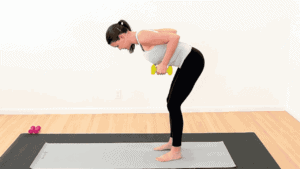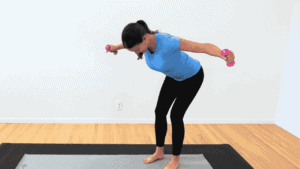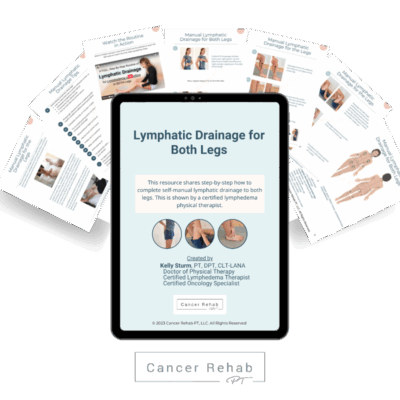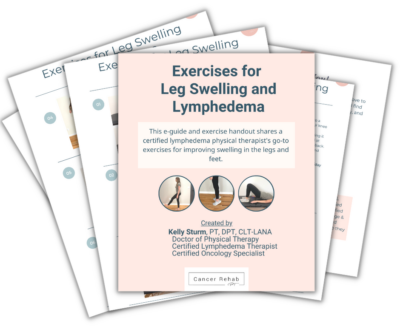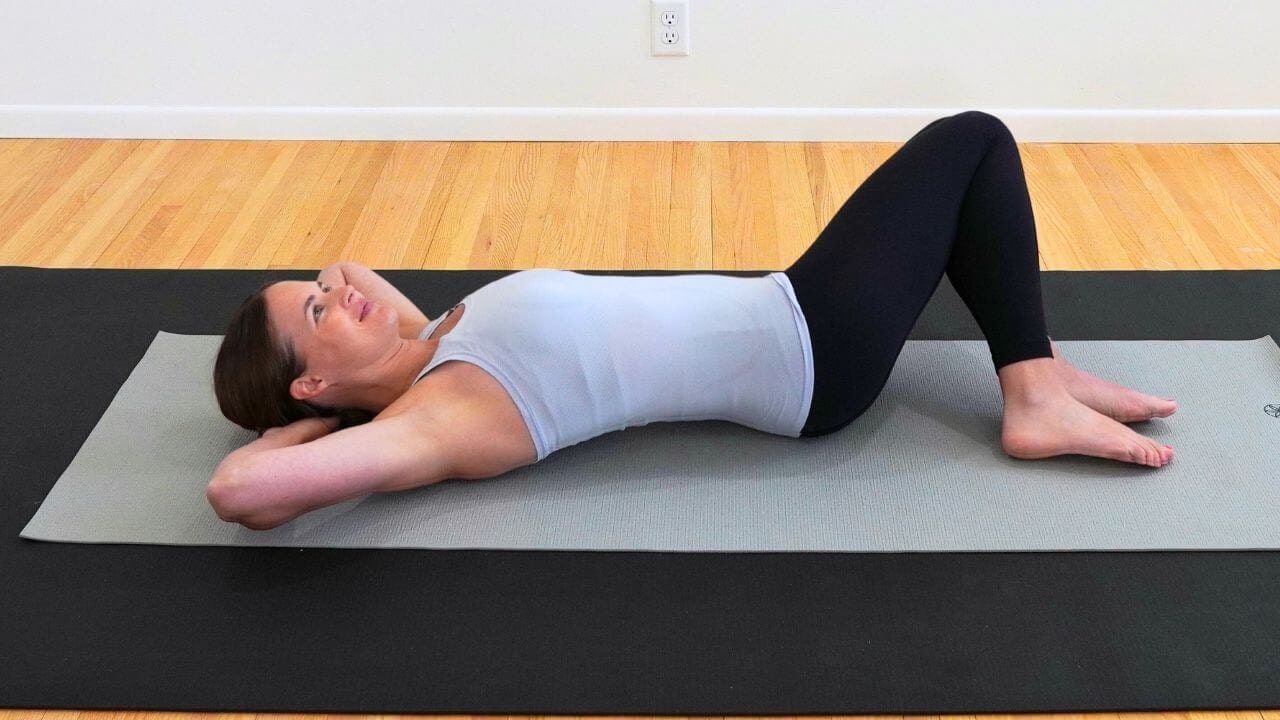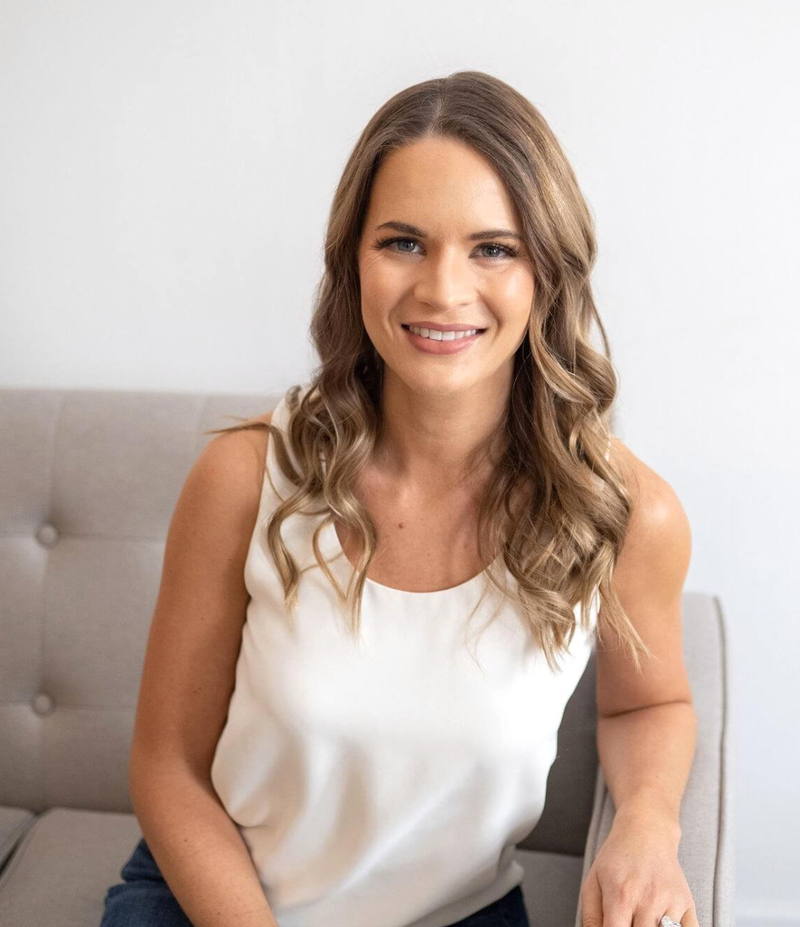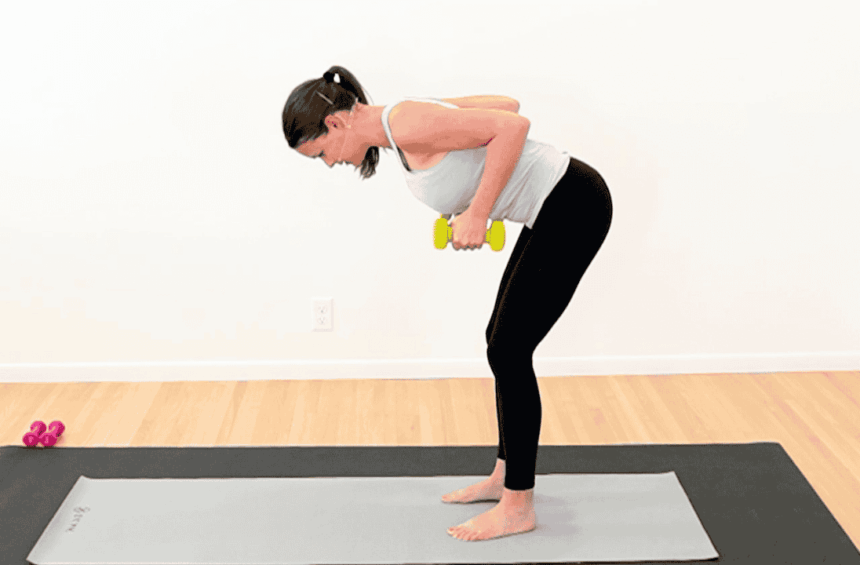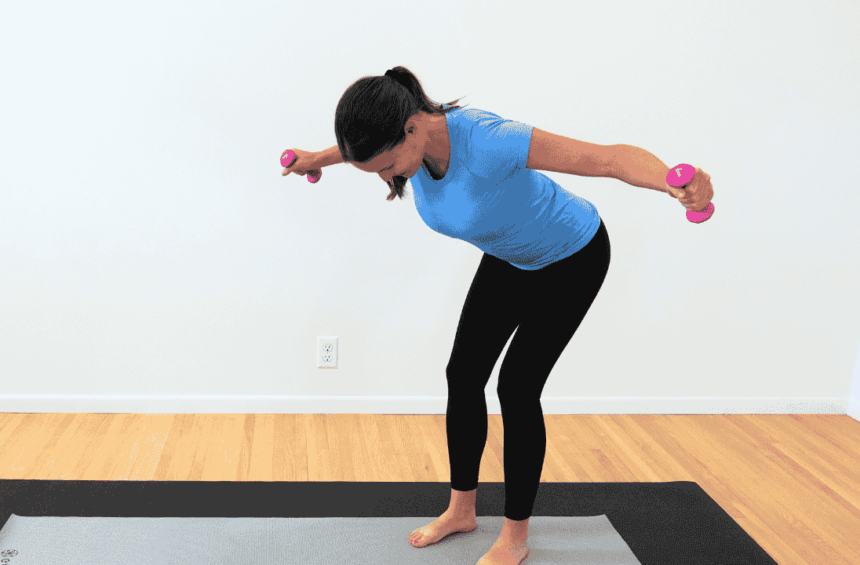Recovering from breast cancer surgery can bring on pain, stiffness, and worry about overdoing it, or wondering where to even begin. Especially those first couple of weeks or months. The good news is that there are gentle and effective breast cancer exercises after surgery that can help you regain motion and get back to your normal daily activities.
My name is Kelly, and I am a certified oncology and lymphedema physical therapist. I specialize in working with patients recovering from breast cancer or those with lymphedema.
In this post, I am sharing my go-to exercises for the 4 to 8 weeks after breast cancer surgery to help ease pain, reduce swelling, and work towards getting a full range of motion back.
These strength and stretching exercises are gentle enough to be done daily, as long as someone is cleared by their doctor first, as everyone has a different surgery and recovery experience.
If you are in the earlier stages of recovery, either with drains still in place or drains recently removed, make sure to begin with Early Exercises After Breast Cancer Surgery: 0-3 Weeks.
Benefits of Physical Activity After Breast Cancer Surgery
Breast cancer surgery can lead to having stiff shoulders and arms. The goal is that one can get back to their normal range of motion as quickly as possible post breast surgery, and this is why we encourage exercise the day after the surgery if possible.
Prioritizing safe arm and shoulder movement daily can help
- Mitigate stiffness and pain
- Reduce swelling
- Encourage optimal blood flow and good circulation
- Maintain normal movement in the arms and shoulders
If someone has had breast reconstruction, they will have different exercises to focus on after their breast surgery. Everyone’s recovery experience is different. Prior to beginning these exercises, one should speak with their healthcare provider or breast care nurse to get safety clearance.
Breast Cancer Exercises After Surgery: 4-8 weeks
In this routine for 4-8 weeks after surgery, we will go through 4 stretching exercises that focus on improving range of motion and pain after surgery, and then 2 light strength exercises to start getting muscles activated again.
These exercises help increase movement and should remain mild without significant pain or strain. If you find yourself experiencing pain, stop exercising and consult your doctor.
These exercises work for both a mastectomy and lumpectomy. There are now more women in the US choosing mastectomy over lumpectomy for early-stage cancer. For a more detailed review of the differences between a mastectomy and lumpectomy, see my blog post Lumpectomy vs. Mastectomy: Making Your Decision.
If you haven’t yet had breast surgery or treatment, it can be helpful to familiarize yourself with recovery expectations, especially if someone is having a double mastectomy. Having an understanding of what to expect can help you feel more prepared and confident in the process.
If you would like to follow along with a video of a certified physical therapist modeling these exercises, you can watch the YouTube video linked below.
Exercise Details
These basic exercises and gentle stretches are for breast cancer patients after surgery. They are done standing and lying down. These exercises are for 4-8 weeks after surgery and focus on arm and shoulder movement.
Equipment Required
- A small ball that doesn’t have weight
- A dowel, such as a PVC pipe, broom handle, or a light golf club
- A mat
Stretches
Stretching is something I always start my patients off with. It’s helpful to ease back into movement to help reduce pain and get blood and lymph fluid moving that may be present from the surgery. Although you may “feel it slightly”, everything should remain gentle and a mild stretch to start.
Shoulder Raises (Lying Down)
This stretch works on shoulder flexion, and there are three different variations, so that someone can modify to best fit their needs.
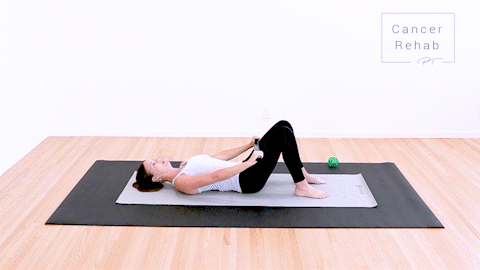
- Begin lying on your mat with your knees bent and feet flat on the ground.
- Keep your arms by your side and elbows straight. Think about keeping your thumbs up towards the ceiling and your shoulders relaxed.
- You are going to slowly lift your arms up over your head, making sure to stop if you feel pain. Raise your hands until you feel a mild stretch and pause there, taking a nice deep breath.
- Slowly lower your arms back down to your sides.
- Complete 8 to 10 times.
Someone may be more comfortable using their dowel or wand of some sort to hold onto, especially if they only have pain on one side.
- Begin in the same position with one hand on top of the dowel and the other on the bottom as a guide.
- Use your bottom hand to gently guide the dowel up until you feel a mild stretch.
- Slowly bring the dowel back down.
- Complete 8 to 10 times on the same side and then switch to the opposite side.
- You can also hold onto the dowel with both hands at the same height and gently guide your arms over your head.
Again, it is important to try the different variations and find what movement works best for you. Make sure to focus on not overcompensating by arching your back and stopping when you feel a mild stretch to prevent pain.
Lying Pec Stretch
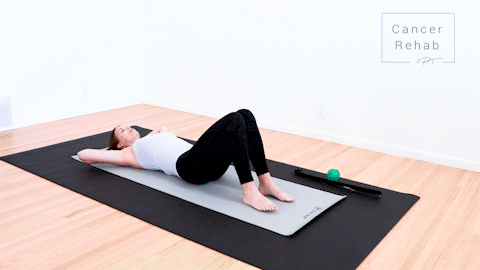
This next exercise is an extension of an exercise someone can do during the early recovery period. If you are in the first 0-3 weeks after surgery, make sure to begin with Early Exercises After Breast Cancer Surgery: 0-3 Weeks.
- Begin on your back with your knees bent and feet on the ground.
- Bring your hands behind your head with your elbows bent and pointed towards the ceiling.
- Allow your elbows to fall to the sides.
- Next, you are going to take your knees and slowly let them fall to one side of your body, holding them there for 3 to 5 seconds as you take a deep breath.
- Bring your knees back to the starting position and then allow them to fall in the opposite direction.
- Continue repeating this side-to-side motion 3 to 5 times.
I encourage you to let your knees fall to alternating sides, even if you feel like you have an unaffected side that doesn’t need stretching. Switching sides allows you to feel the difference and gives you a better understanding of which areas of your body need more stretching for movement improvement.
Wall Slides
This next stretch focuses on shoulder movement. You can either do the wall climbing with both arms at the same time or focus on one arm and then the other.
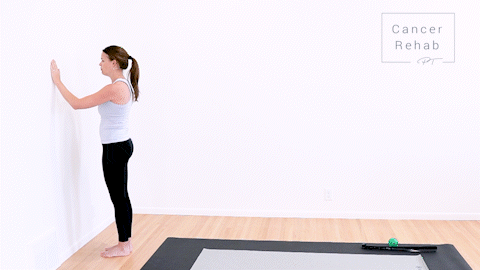
- Stand facing a wall. Bring your elbows up to 90 degrees, pressed flat against the wall. This is the distance you want to be from the wall.
- Place your hands, palms facing forward, flat on the wall and slide your fingers slowly up the wall, reaching above shoulder height. This allows the wall to take a little bit of the weight in your hand.
- Feel the mild stretch at the top and pause for a few seconds before slowly bringing your hand back down.
- Repeat 3 to 5 times to start, working your way up to 8 to 10 times as you become more comfortable.
- Repeat with the other arm.
Shoulder External Rotations
This next exercise helps with the rotator cuff and is really good for shoulder health, especially after surgery.
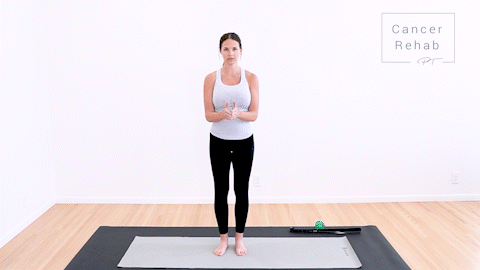
- Begin standing with your elbows bent and tucked right into your side. Your thumbs are facing up towards the ceiling.
- Slowly rotate your arms outwards, keeping your elbows tucked. This is called an external rotation outwards and is where someone should feel the mild stretch.
- Slowly rotate your arms back in.
For a modification, someone can use their dowel to guide the movement.
- Place both hands on the dowel with both thumbs pointed in the direction you are moving.
- Keep your elbows at your side and complete a windshield wiper movement with the dowel.
- Repeat 8 to 10 times and then switch directions to focus on the opposite side.
Strength
In many cases, after breast cancer treatment, someone can find themselves really tight as they have naturally been rounding in their shoulders. These strength movements help stretch across the chest while also strengthening the back muscles to help bring your shoulders down and back. This also encourages better alignment, which helps your shoulders avoid long-term issues.
Scapular Squeezes
This shoulder exercise after breast cancer surgery, works on your postural muscles as you engage in scapular squeezes.
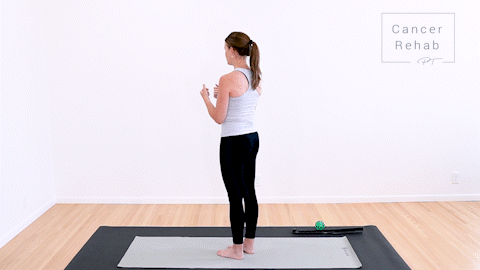
- Stand in a neutral position with your arms bent at a 90-degree angle at your sides.
- Take your shoulder blades and pinch them back and down together, getting a slight squeeze before releasing.
- Come back to the front.
- Repeat 8 to 10 times, keeping your shoulders down and relaxed.
Ball Wall Circles (With a Punch)
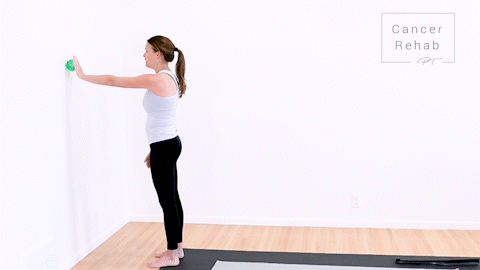
- For this last exercise, you will need your ball.
- Begin standing an arm’s length distance from the wall.
- Hold the ball in your hand and punch your arm towards the wall, keeping your elbow straight. The ball should touch the wall as you are reaching forward.
- When you are in the correct position, slowly create 10 circular motions with your ball in one direction and then change direction.
- Repeat with the other arm.
As your arm gets tired, you should feel it getting heavy. This exercise is helping work on your shoulder strength and shoulder stability, which is going to help you get back to doing your usual activities over time with fewer problems.
What to Expect from Breast Cancer Recovery
Recovering from breast cancer surgery can come with pain, limitations, and discomfort. Some people even experience swelling in the arms, chest, or other parts of their body, which may be a sign of lymphedema. The good news is that it is possible to feel like yourself again and live a full life after cancer.
My Breast Cancer Rehab program supports those recovering from breast cancer through an online, self-paced course that helps minimize pain, build up pain, and improve your quality of life.
FAQs
How soon can I lift weights after a mastectomy?
This depends on your specific surgery and healing, so you’ll need clearance from your surgeon first. Generally, most people can start with very light weights (1-2 pounds) around 4-6 weeks post-surgery, but only after your incisions are fully healed and you have basic arm mobility back. Start slow and listen to your body. If you had lymph nodes removed, it’s especially important to work with a physical therapist who understands lymphedema risk to help you progress safely.
What exercises should I do after a lumpectomy?
Start with gentle range of motion exercises as soon as your doctor clears you – usually within a few days. Focus on shoulder rolls, arm circles, and gentle stretches to prevent stiffness. Wall slides and doorway stretches help restore overhead motion. The key is starting early but going gentle. If you’re experiencing tightness, pulling sensations, or limited motion after a couple weeks, consider working with a cancer rehabilitation physical therapist to get back on track.
What exercises prevent lymphedema after lumpectomy?
Regular movement is your best prevention tool. Focus on exercises that activate your arm and shoulder muscles – like gentle arm pumps, shoulder blade squeezes, and progressive strengthening as you heal. The goal isn’t intense workouts – it’s consistent, gentle movement that keeps your lymphatic system flowing. If lymph nodes were removed, work with a certified lymphedema therapist for personalized guidance.
When can you lift arms overhead after a mastectomy?
Most people can start working toward overhead motion around 1-2 weeks post-surgery once drains are removed, but full overhead reach typically takes 4-8 weeks depending on your healing and whether you had reconstruction (and if your surgeon has cleared you). Start with gentle range of motion exercises and gradually work up to overhead reaches. Don’t force it – let your body guide the timeline. Scar tissue and muscle tightness can limit motion, but both are treatable with support from physical therapy.
Final CTA
Gentle stretches and strength exercises can be very beneficial in helping someone recover faster after breast cancer surgery. After receiving clearance from your doctor, begin with gentle physical activity to help regain normal movement.

